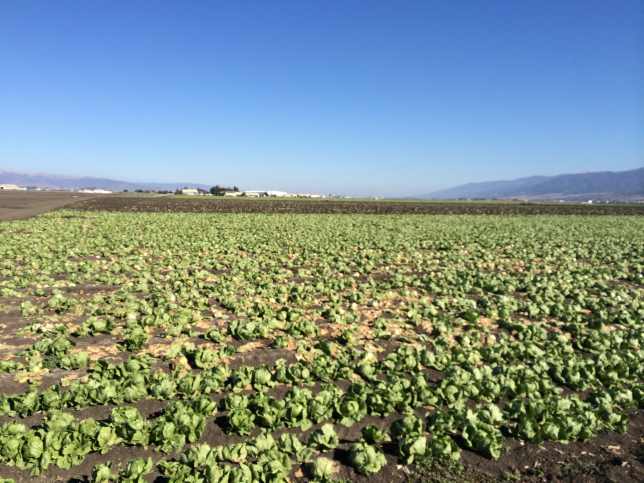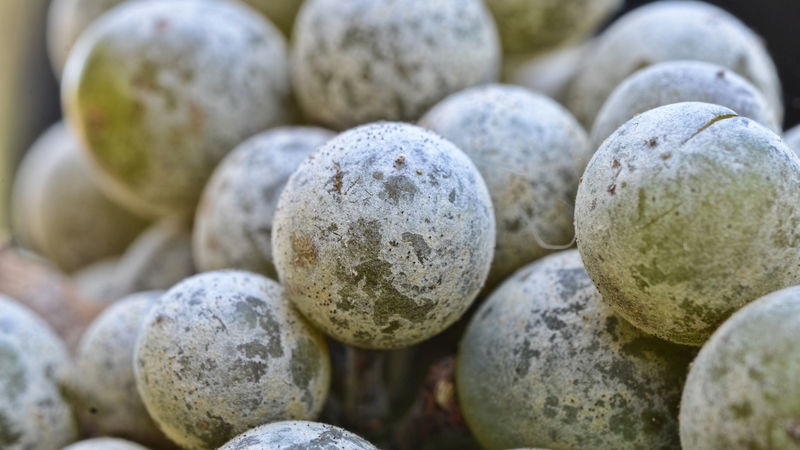Aphid Outbreak Leads To “Staggering” Losses
The foxglove aphid (FGA) made its presence known this year in California, targeting lettuce in specific areas of the state. In fact, one researcher said the losses in those areas were “staggering.”
Shimat Joseph, an IPM advisor with Cooperative Extension in Monterey County at the University of California, says lettuce growers began noticing the insect pest in fields in July, with most of the infestations concentrated in Salinas and Gonzales.

Most of the foxglove aphid infestations were concentrated in Salinas and Gonzales as well as areas in the Salinas Valley. Photo credit: Shimat Joseph
Mary Zischke, the CEO of the California Leafy Greens Research Board in Salinas, says there have been a few fields where nothing was harvested and others where the yields were substantially reduced due to the presence of the aphid.
“It hasn’t been a huge percentage of the acreage that’s been severely impacted, but with growing costs in the territory of $4,200 per acre, the losses do add up fast,” she says. “And there’s the lost opportunity cost, because markets have been quite good this season.”
Cause Of Infestation Unclear
Although a pest of lettuce, the insect is typically prevalent on weeds. Joseph says in most situations, the FGA rarely causes significant economic damage in lettuce.
So what happened this year? He says researchers are unclear as to the exact cause of the infestations, but adds that environmental conditions, such as warm nights and high humidity in the area, may have favored FGA population growth.
Aphids: Lettuce Vs. Foxglove

The foxglove aphid is yellowish to green in color. Photo credit: Shimat Joseph
When combating aphids on lettuce, Joseph says it is important to know which one you are up against. The lettuce aphid can be found in the crop as well, and the two pests look very similar.
“The FGA has the distinct green patch at the base of the tube-like-structure called the cornicle, which is at the back of the aphid,” Joseph explains. “However, this patch is absent on lettuce aphid.
Generally, FGA is yellowish to green in color, whereas lettuce aphid is red or pink. Although FGA can make colonies on the growing points located in the center of the lettuce, their colonies were found in the layers between cap (outer) leaves and young leaves in the center.”
Management Techniques
To successfully manage FGA, early detection is critical, so scout your crops weekly. Once an infestation occurs, the pest moves into the inner layers of lettuce and produces colonies, which means the insects are less likely to be exposed to insecticides with contact properties.
“It is also likely they will evade systemic insecticides as most of the insecticides tend to move to the growing points of the plant,” Joseph says. “So far, we only observed the problem close to harvest, which suggests the infestation is happening about 20 days to harvest.”
The good news is there are several chemistries that can be used to control FGA. They include Movento (Bayer CropScience), Actara (Syngenta Crop Protection), Admire Pro (Bayer CropScience), Fulfill (Syngenta Crop Protection), and Beleaf (ISK BioSciences, FMC Corp).
According to Joseph, Movento, Fulfill, and Admire Pro insecticides move systemically in the plant, whereas Actara is translaminar and controls aphids mostly by contact. Beleaf has contact and systemic properties.
It is important to remember that Movento needs about 14 days to be most effective while Beleaf is toxic within an hour of application, he adds.
“Perhaps reducing the water volume and use of adjuvants would increase the effectiveness of systemic insecticides,” Joseph explains. “This will reduce the run off of the chemical already sprayed. If [an FGA outbreak] happens, the tendency among growers is to increase the water volume or dilute the insecticide, which will lead to run off or the insecticide not staying on the plant surface.”
New insecticides such as Closer or Sequoia (both from Dow AgroSciences) and Sivanto (Bayer CropScience) were also found to be effective against aphids in a research trial but are not currently registered in California, he says.
Alternative Controls
Alternative methods to help you fight FGA, such as aphid predators and parasites, also can be used. Joseph says planting strips of sweet alyssum within lettuce fields encourages the incidence of various species of hover flies.
“The flowers of sweet alyssum provide food (nectar) for adult flies as they hover in the lettuce fields and lay eggs in the aphid colonies,” he explains. “The larval stages of these flies feed on aphids and help growers manage [the pest]. In some areas, aphid densities were suppressed by parasitic wasps.”
Concern For 2015
Will FGA be a problem next year? Joseph says that is difficult question to answer.
“It may,” he says, “if the ideal environmental conditions for growth and development persist and sustain longer during the growing period, or the alternate hosts (weeds) are available in abundance.”










